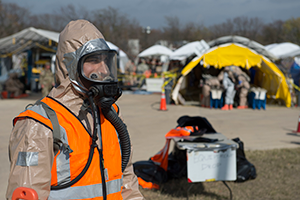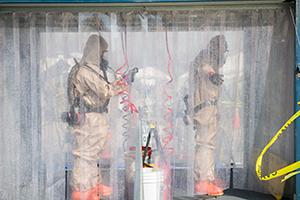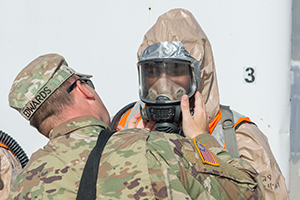Story and Photos by Andrew R. Smith, TMD Public Affairs

ROUND ROCK, Texas Dec 5, 2019 — A National Guardsmen from the Texas based 36th Infantry Division, CBRNE Task Force, stands a decontamination boundary watch as part of a FEMA certification. These drills are an important preparation for disasters that may occur in FEMA region 6. (U.S. Army Photo by Andrew R. Smith/Released)
ROUND ROCK, Texas, Dec. 5, 2019 – National Guard units from Texas and Louisiana met at the Round Rock Public Safety Training Center for an emergency response training evaluation. The training of the day was a large staged incident that rated the Guard units’ response to a simulated chemical, biological, radiological or nuclear contamination incident. The units had to set up and maintain contamination boundaries, perform search and extraction of crisis actors, decontaminate the actors and provide medical triage care for any injured actors.

ROUND ROCK, Texas Dec 5, 2019 — National Guardsmen from the Texas based 36th Infantry Division, CBRNE Task Force, perform washdown drills as part of a FEMA certification. These drills are an important preparation for disasters that may occur in FEMA region 6. (U.S. Army Photo by Andrew R. Smith/Released)
The Texas-based Chemical, Biological, Radiological, Nuclear and Explosive Task Force took part in the training exercise and activated nearly 200 Guardsmen and more than a dozen vehicles as part of the training event.
The exercise was a combined green and white exercise, with the “green” referring to military personnel and the “white” referring to local first responders. Observers graded the National Guard units taking part in the training on the day’s response efforts. The U.S. Army Test and Evaluation Command sent personnel to observe and grade CBRNE Task Force’s efforts and rate its level of preparation to respond to a real-world event of a similar nature.
Due to the extensive training and requirements to set up and properly use the decontamination equipment, as well as CBRNE’s unique cooperation with local authorities and disaster response units, the unit has a very high training tempo. Guardsmen in the unit often have to devote additional time to training and certifications such as this one.
“Our unit works with a variety of local agencies,” said Maj. Bradley Smejkal, executive officer of CBRNE Task Force. “Due to these missions, all of our traditional Guardsmen have to balance the green and white mission. We do a lot of extra training including additional annual training, most of which is devoted to cooperating with and being certified by the white side.
“If you can’t protect yourself and your personnel, you’ll become an additional casualty. We are here to help, not hinder, local assets. To assist them, we bring in our own gear and train to meet the local standards.”

ROUND ROCK, Texas Dec 5, 2019 — National Guardsmen from the Texas based 36th Infantry Division, CBRNE Task Force, check respirators before preforming decontamination drill as part of a FEMA certification. These drills are an important preparation for disasters that may occur in FEMA region 6. (U.S. Army Photo by Andrew R. Smith/Released)
The scenario utilized numerous crisis actors whose independent actions added realism and chaos to the exercise.
“I learned a lot from the exercise and the presence of the crisis actors. I saw firsthand how civilians under stress can be random and unpredictable,” said Pfc. John Albert Dearing Jr., a member of the unit. “It is important to explain any instructions clearly and keep them updated with the status of the situation.”
By the end of the first day, the task force completed all of the tasks associated with the training. However, the event had more tasks and challenges to follow over the next two days.
The combined training of Texas and Louisiana guard units alongside local responders helps to organize all assets that might respond to a disaster in FEMA region 6, which encompasses much of the southwestern United States. The training was coordinated by the 136th Maneuver Enhancement Brigade in coordination with local authorities, in preparation for potential disaster response. The 136th MEB is the brigade-level command for CBRNE Task Force.